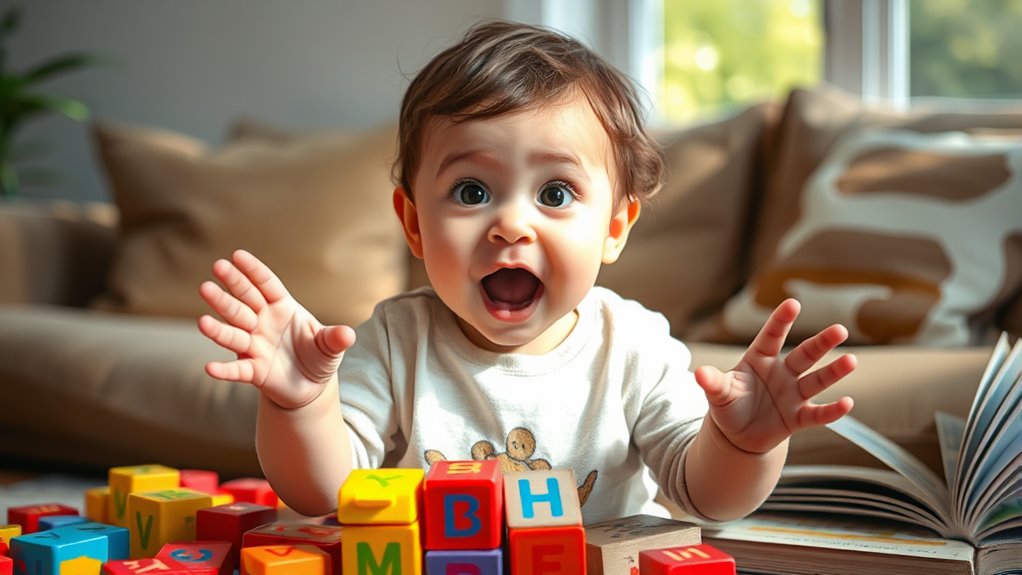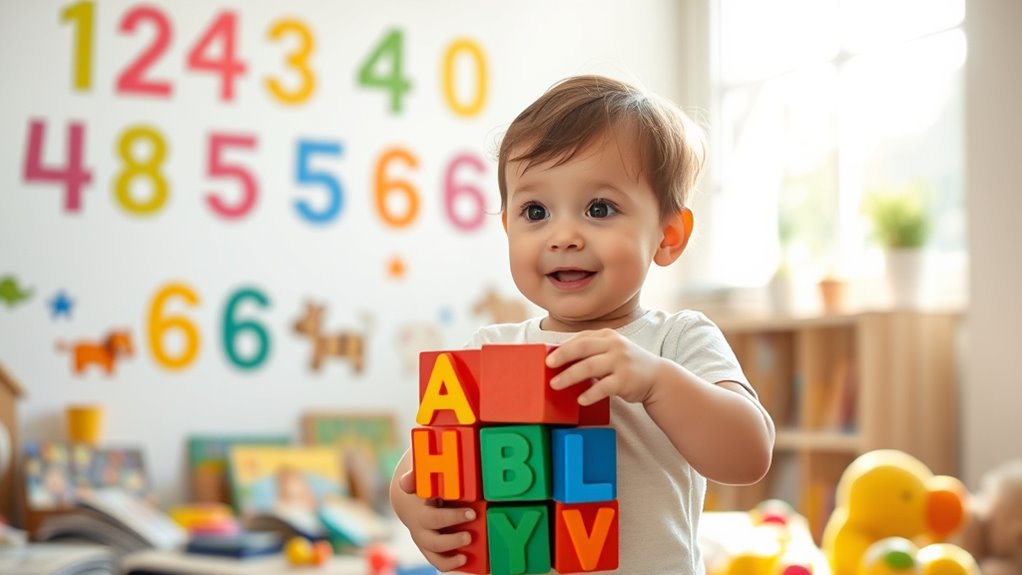Between ages two and three, your child goes through a language explosion, rapidly growing their vocabulary from dozens to hundreds of words. They start combining words into phrases and experimenting with sentence structure, adding basic grammar like -ed or -ing. Their pronunciation improves, and they begin asking questions, showing understanding of more complex ideas. This exciting phase reflects their expanding comprehension and expressive skills. Keep exploring to learn how to support this incredible developmental milestone.
Key Takeaways
- Toddlers rapidly expand their vocabulary from dozens to hundreds of words during this period.
- They begin forming full sentences and experimenting with grammatical structures like “-ed” and “-ing.”
- Longer, more complex sentences reflect growing understanding of syntax and language rules.
- Exposure to conversations and reading supports vocabulary growth and grammatical development.
- Variability in development is normal; this phase marks a significant leap in communication skills.

Have you ever wondered why your toddler suddenly starts speaking in full sentences around age two or three? It’s an exciting phase where language skills seem to explode overnight. During this time, your child’s vocabulary development accelerates rapidly. Suddenly, they’re not just saying “milk” or “ball,” but combining words into phrases like “want more milk” or “big red ball.” This growth reflects their expanding understanding of the world and their ability to express themselves more clearly. You’ll notice that their vocabulary jumps from a few dozen words to hundreds within a few months. This isn’t just about memorizing words; it’s about your child learning how to categorize objects, actions, and feelings, which helps them communicate more effectively.
Toddler language bursts with full sentences and new words, marking exciting growth in understanding and communication skills.
As your toddler’s vocabulary grows, so do their grammar milestones. They begin experimenting with sentence structure, moving from simple single words to more complex combinations. You’ll hear them start to use basic grammatical rules like adding “-ed” to indicate past tense or “-ing” for ongoing actions, even if not perfectly. For example, “goed” instead of “went” or “running” instead of “ran” might pop up, but that’s part of their learning process. They’re absorbing the rules of language through exposure and practice. Expect to hear more questions like “Where daddy go?” or “Why cat sleeping?” These questions show they’re starting to grasp how language helps them inquire about their environment and seek understanding.
This period is also marked by your child’s ability to connect ideas and form longer sentences. They might string together three or four words, such as “I want cookie” or “Mommy go store,” showing they’re beginning to understand syntax—the arrangement of words to create meaning. Their pronunciation improves too, making their speech more intelligible. This is a fundamental part of language development because it indicates they’re refining their phonological skills, which are essential for future reading and writing. Additionally, advances in automated systems and cognitive processing help support these rapid language gains by enabling children to absorb and produce more complex language patterns.
During this explosion of language, your role is essential. Engaging in conversations, reading aloud, and encouraging your child to express themselves help reinforce these milestones. Celebrate their efforts, even if their grammar isn’t perfect yet. Remember, this is a normal phase of rapid growth, and every child develops at their own pace. By providing a language-rich environment, you’re helping them build the foundational skills they’ll need for more complex language and communication skills in the years to come.
Frequently Asked Questions
How Can Parents Best Support Language Development at This Stage?
You can support your child’s language development by engaging in daily activities like reading stories and singing nursery rhymes together. Use simple, clear language and encourage your child to repeat words or phrases. Ask questions about the stories and rhymes to spark conversation. By actively participating and providing a rich language environment, you help your child expand their vocabulary and improve their communication skills during this exciting language explosion phase.
What Are Common Speech Milestones for 2-3-Year-Olds?
Like a sponge soaking up water, your toddler’s speech milestones include understanding simple instructions and using two to three-word phrases. They begin naming familiar objects, ask questions, and use pronouns correctly. Their vocabulary expands rapidly, sometimes reaching 200 words or more. You’ll notice improved speech comprehension, making conversations more meaningful. Celebrate these milestones, as they mark your child’s growing confidence and ability to communicate effectively.
When Should Parents Seek Help for Speech Delays?
You should seek help for speech delays if your 2-3-year-old isn’t using simple words or combining words by age two. Early intervention can make a big difference, so don’t wait if you’re concerned. Speech therapy can support your child’s language development and address delays promptly. Trust your instincts, and consult a professional if you’re worried about your child’s progress—early help sets the foundation for better communication skills.
How Does Bilingual Exposure Affect Language Explosion?
Bilingual exposure can enrich your child’s language explosion by encouraging code switching, which helps them navigate both languages smoothly. It might slow vocabulary expansion in each language temporarily, but overall, children develop a broader vocabulary and better cognitive skills. You’ll notice your kid switching between languages naturally, which is a sign of healthy bilingual development. Keep supporting their exposure, and they’ll thrive in both languages during this exciting language explosion phase.
What Role Do Play and Interaction Have in Language Growth?
You might think play and interaction are just fun, but they’re actually the secret sauce for language growth. Through playful communication and interactive reading, you encourage your child to experiment with words and sounds, boosting their vocabulary and confidence. When you engage actively, you turn everyday moments into language-rich opportunities, making learning feel like a game. So, keep those conversations lively—you’re cultivating a little linguist with every giggle and shared story.
Conclusion
As you watch your little one’s vocabulary blossom, it’s like witnessing a mini Tower of Babel rising from chaos. Their words become bridges, connecting thoughts and feelings with newfound confidence. Just as Da Vinci once saw endless potential in a blank canvas, your child’s language explosion reveals the vibrant masterpiece of their mind. Embrace this magical phase, knowing it’s the foundation for a future full of stories, dreams, and endless possibilities.









